Perugia-10 Things to do and Visit

Perugia is a little gem that unfolds slowly before the eyes of visitors. The Umbrian town holds art treasures and monuments that bear witness to the rich past and do justice to the cultural primacy of our country. Although it retains the look and pace of life in a small walled medieval town, Perugia has a very busy city life, mainly from the presence of one of the oldest University of the peninsula (founded in 1308), as well as the increased university for foreigners in Italy.
It is therefore not a city museum, full of tourists during the day and empty at night, but a place in which to spend a little more hit and run of a visit dedicated to the major monuments. From the National Gallery to the Etruscan Well, the Oratory of San Bernardino to Corso Vannucci, below we suggest 10 things to do and must-see during a visit to Perugia. The rest is a surprise to find out for yourself.
1) The Fontana Maggiore – The Great Fountain
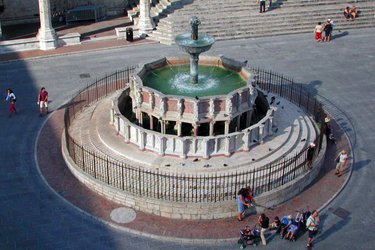 At the center of Piazza IV Novembre is this beautiful fountain, one of the most famous in Italy and symbol of medieval Perugia. The Great Fountain was built between 1275 and 1278, designed by Nicola and Giovanni Pisano, to receive water from the Aqueduct of Mount Pacciano. The two artists took the Fountain on a circular staircase, consisting of two tanks of pink and white stone, topped by a hollow bronze.
At the center of Piazza IV Novembre is this beautiful fountain, one of the most famous in Italy and symbol of medieval Perugia. The Great Fountain was built between 1275 and 1278, designed by Nicola and Giovanni Pisano, to receive water from the Aqueduct of Mount Pacciano. The two artists took the Fountain on a circular staircase, consisting of two tanks of pink and white stone, topped by a hollow bronze.
From here emerge three nymphs supporting an amphora from which water flows. The bowl rests on top of the columns from which rise statues of mythical characters related to the foundation of the city; the lower basin, however, is decorated with fifty panels depicting the agricultural calendar, some biblical, historical and mythological, the two symbols of the city (the griffin), the Guelph party (the lion) and Empire (the ‘eagle). Conclude the seven liberal arts and philosophy. Singular presence in the tiles of two scenes from Aesop’s Fables (cranes and Wolf & Wolf and lamb). After the last renovation, today can admire the work in all its original splendor.
2) The Cathedral of San Lorenzo
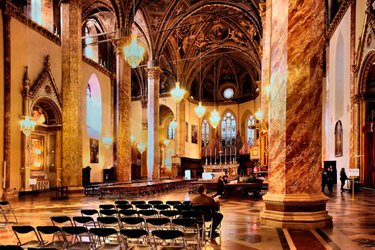 Work on the construction of the Cathedral dedicated to San Lorenzo, one of the patron saints of the city, they began in 1345 and ended in 1490. Both the side panel that the main facade, however, remained incomplete.
Work on the construction of the Cathedral dedicated to San Lorenzo, one of the patron saints of the city, they began in 1345 and ended in 1490. Both the side panel that the main facade, however, remained incomplete.
Side guard overlooking the Fontana Maggiore, and a geometric pattern of diamond shapes of pink and white marble decorates only the bottom side. The main facade, however, overlooks Piazza Danti and is characterized by a Baroque portal of 1729. The interior of late Gothic imprint, has three naves of equal height, divided by massive pillars. The decorations were completed in the eighteenth century, and among them, stand out the Deposition of Federico Barocci, the stained-glass window of the XVI century Flemish Arrigo and the Funeral Monument in honor of the bishop Andrea Baglioni made by Urbano da Cortona. In the cloister of the Cathedral you can visit the Cathedral Museum, home to major works of art.
3) The National Gallery of Umbria
 Corso Vannucci, the top floors of the Palazzo dei Priori is located, since 1878, the National Gallery of Umbria. The Gallery houses one of the most complete and rich artistic heritage of the region.
Corso Vannucci, the top floors of the Palazzo dei Priori is located, since 1878, the National Gallery of Umbria. The Gallery houses one of the most complete and rich artistic heritage of the region.
The works cover a period from the thirteenth to the nineteenth century and are organized according to an exhaustive chronological: the third floor is a compilation of works from the thirteenth to the fifteenth century; The second floor from the sixteenth to the nineteenth century. Unlike other large Italian and foreign museums, the National Gallery of Umbria masterpieces are collected in a small space, then one another relentlessly. They admire in a single glance the altarpieces and Madonnas of the Florentine and Sienese painting of 1400, alongside masterpieces of the Renaissance, the unique jewelery umbra. Among them, stand out masterpieces by Duccio, Piero della Francesca, Fra Angelico, Pinturicchio and Perugino. In addition, collected monographic dedicated to gold, the ancient graphics, topography and Umbrian fabrics enrich the collection.
4) Rocca Paolina
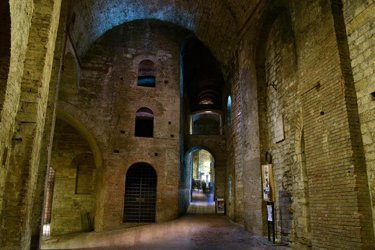 Praised in a famous poem of Carducci, the Rocca Paolina is an ancient fortress built by Pope Paul III and built by Antonio da Sangallo the Younger. The intention of the Pope, when he was still alive the memory of the Sack of Rome, was to make the city safer and thereby create a refuge efficient as it had been Castel Sant’Angelo. Its construction necessitated the destruction of more than a hundred houses but also of monasteries and churches, mainly owned by the Baglioni family, hated by the Pope.
Praised in a famous poem of Carducci, the Rocca Paolina is an ancient fortress built by Pope Paul III and built by Antonio da Sangallo the Younger. The intention of the Pope, when he was still alive the memory of the Sack of Rome, was to make the city safer and thereby create a refuge efficient as it had been Castel Sant’Angelo. Its construction necessitated the destruction of more than a hundred houses but also of monasteries and churches, mainly owned by the Baglioni family, hated by the Pope.
The Rocca was symbol of papal authority until 1860, when it was demolished following the annexation to the Kingdom of Italy. Of that ancient building they are a visible part of the walls and the bastion of support incorporating Porta Marzia. The most striking part of what remains of the Rocca Paolina are underground, especially the escalators from the parking lot of Piazza Partisans through the Rock on the porch side of the Government Palace (1870, seat of the Province) and arrive in Piazza Italia. In this unique setting and evocative, a kind of city within a city, there are shops, boutiques, bookshops and often organize cultural events.
5) The Oratory of Saint Bernardino
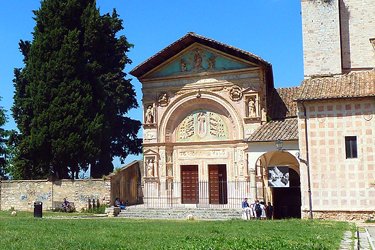 The oratory was built by Franciscan friars in honor of Saint Bernardino of Siena, whose preaching had inflamed the Perugia on several occasions. The magnificent polychrome façade was made by Agostino di Duccio who, using different materials, he managed to create a veritable symphony of colors exploding in a fascinating play of light.
The oratory was built by Franciscan friars in honor of Saint Bernardino of Siena, whose preaching had inflamed the Perugia on several occasions. The magnificent polychrome façade was made by Agostino di Duccio who, using different materials, he managed to create a veritable symphony of colors exploding in a fascinating play of light.
In a fine embroidery of stones and marbles, Agostino di Duccio had managed to glorify Bernardino and narrating his miracles. The work of Augustine is the most important Renaissance monument in Perugia. A double door leads the visitor inside the plant Gothic, whose altar is made up of an early Christian sarcophagus of the fourth century that holds the remains of Blessed Giles, a companion of St. Francis. Behind the altar, another portal introduces the Oratory of St. Andrew with a coffered ceiling and paintings of the eighteenth and nineteenth centuries.
6) The Etruscan Well
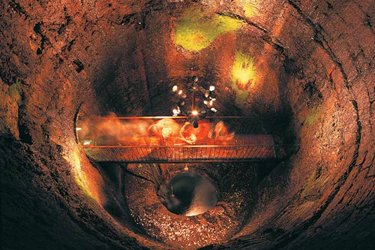 Belonged to the Corbello’s family, the Etruscan well is a great engineering work that testifies to the technical knowledge and the degree of civilization attained by the people of Perugia already 300 years before Christ.
Belonged to the Corbello’s family, the Etruscan well is a great engineering work that testifies to the technical knowledge and the degree of civilization attained by the people of Perugia already 300 years before Christ.
It seems that its construction dates back to the fourth or third century b.C., but although the date is uncertain about its size, there are no doubts: 37 meters deep to over 5 meters in diameter. An immense building that was formerly a water tower: here there flowed the waters of three veins aquifers of Perugia. Currently the Well is feasible thanks to a system of steps that allow you to go down to the deepest point. The fund is partly covered with travertine blocks which were also used for the cover. If you find yourself in Piazza Danti, near the Fontana Maggiore, do not miss the opportunity to admire this unique work of hydraulic engineering.
7) The House of Chocolate Perugina
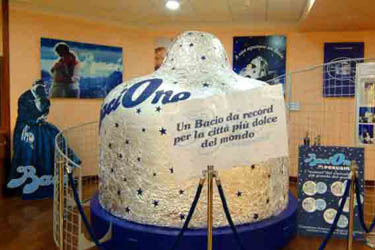 Not many people associate the famous Baci Perugina to Umbrian city, where instead they are named. Originally known as the “cazzotti” have become an icon in the world.
Not many people associate the famous Baci Perugina to Umbrian city, where instead they are named. Originally known as the “cazzotti” have become an icon in the world.
The factory of Perugina is located just outside the old town and you can visit it by discovering the history of the company and, above all, observe the production of other products and kisses (Rossana candies, cookies Ore Liete). The visit to the house of Perugina chocolate takes about 1h and 15min and allows you to discover the historical museum, the visit to the production lines of chocolate, a beautiful and rich tasting of Perugina, and finally access to the interior store.
8) Volumni Hypogeum
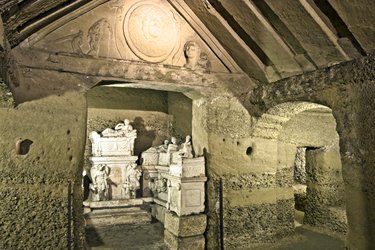 Just outside the historic center of Perugia, near Ponte San Giovanni, there is an extraordinary place of Etruscan, is the Hypogeum of the Volumni, the oldest and preserved funerary monument of Etruscan.
Just outside the historic center of Perugia, near Ponte San Giovanni, there is an extraordinary place of Etruscan, is the Hypogeum of the Volumni, the oldest and preserved funerary monument of Etruscan.
The tomb of the third century. b.C, discovered in 1840, is part of the vast necropolis, known as the “Palazzone”. A necropolis with more than 200 graves, of which only a part can be visited. The underground is named Volumni, rich and noble Etruscan family, which contains the remains. The beauty of the building is its characteristic shape house of Etruscan-Roman period it consists of 7 rooms and 1 atrium.
9) What to eat in Perugia
 The cousine is linked to the traditional Umbrian , for this is simple, genuine and quality. Hams, salami, cheeses and meats are the real stars of the boards.
The cousine is linked to the traditional Umbrian , for this is simple, genuine and quality. Hams, salami, cheeses and meats are the real stars of the boards.
In restaurants, including traditional dishes, you can taste the “guinea fowl in the drip pan” (seasoned with a sauce made of chicken livers, herbs and white wine), the “torta al testo” (a cake of flour, water and olive’s oil) and various recipes whose main condiment is the truffle. Another specialty of this city is the parmigiana humpbacks: a dish of cockles, mozzarella, meat sauce and parmesan cheese. Do not miss the flavors of the sea: tegamaccio (a flavored fish soup) is one of the dishes of fish next to the most famous crabs, trout, pike and carp cooked recipes tasty and imaginative. To complete the room, the desserts: pinoccate, made with pine nuts, and a winepress, a donut with raisins and candied fruit, are the most famous.
10) Where to sleep in Perugia
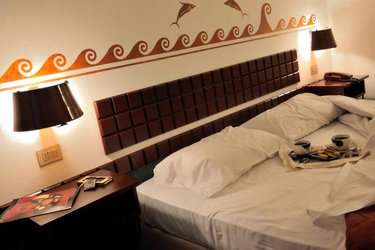 Among the solutions for accomodations that Perugia offers, it must be said that the farms are actually more prevalent in cities as in the whole region. There are no missing hotels, apartments, hostels and B&B to give tourists the opportunity to choose the accommodation they prefer.
Among the solutions for accomodations that Perugia offers, it must be said that the farms are actually more prevalent in cities as in the whole region. There are no missing hotels, apartments, hostels and B&B to give tourists the opportunity to choose the accommodation they prefer.
By moving from the city center or in residential areas near Perugia, you will have the option to choose from your solutions more appropriate and then come back in the city comfortably using public transport. At events like Umbria Jazz or the Eurochocolate, the influx of tourists in the city is considerable; so if your stay coincides with these periods, book a bit ‘of time before.
BOOK ACCOMMODATION IN PERUGIA
If you are planning your next trip to Italy book hotels, flights, rental cars at best price guaranteed!


